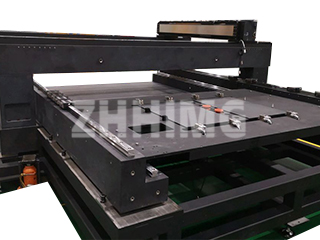When investing in a custom precision granite platform—whether it’s a massive CMM base or a specialized machine assembly—clients aren’t buying a simple commodity. They are purchasing a foundation of micron-level stability. The final price of such an engineered component reflects not just the raw stone, but the intense labor and advanced technology required to achieve certified metrology standards.
At ZHONGHUI Group (ZHHIMG®), we find that the total cost of a customized platform is primarily determined by three critical, interconnected factors: the sheer scale of the platform, the demanded accuracy grade, and the complexity of the component’s structure.
The Scale-Cost Relationship: Size and Raw Material
It seems obvious that a larger platform will cost more, but the increase isn’t linear; it grows exponentially with size and thickness.
- Raw Material Volume and Quality: Larger platforms require larger, flawless blocks of high-density granite, such as our preferred Jinan Black. Sourcing these exceptional blocks is costly because the larger the block, the higher the risk of finding internal flaws like fissures or cracks, which must be rejected for metrology use. The granite material type itself is a major driver: black granite, with its superior density and finer grain structure, is often more expensive than lighter-colored alternatives due to its superior performance properties.
- Logistics and Handling: Moving and processing a 5,000-pound granite base demands specialized equipment, reinforcing the infrastructure within our facilities, and significant dedicated labor. The sheer shipping weight and complexity of transporting a massive, delicate precision component adds substantially to the final cost.
The Labor-Cost Relationship: Accuracy and Flatness
The most significant non-material cost element is the amount of highly skilled labor required to achieve the necessary precision tolerance.
- Precision Grade: Precision is defined by flatness standards like ASME B89.3.7 or DIN 876, which are categorized into grades (e.g., Grade B, Grade A, Grade AA). Moving from a Toolroom Grade (B) to an Inspection Grade (A), or especially to a Laboratory Grade (AA), dramatically increases cost. Why? Because achieving tolerances measured in single microns requires specialized manual lapping and finishing by experienced master technicians. This delicate, time-consuming process cannot be fully automated, making labor the core driver of ultra-high precision pricing.
- Calibration Certification: Official certification and traceability to national standards (like NIST) involves detailed, measured verification using sophisticated equipment like electronic levels and autocollimators. Obtaining a formal ISO 17025 accredited certificate adds an extra layer of cost reflecting the rigorous documentation and testing required.
The Design-Cost Relationship: Structural Complexity
Customization means going beyond a simple rectangular surface plate. Any departure from a standard slab introduces structural complexity that demands specialized machining.
- Inserts, T-Slots, and Holes: Every feature integrated into the granite, such as steel inserts for mounting equipment, T-slots for clamping, or precise through-holes, requires meticulous, high-tolerance machining. Placing these features accurately is essential for the platform’s function and requires slow, careful drilling and milling to avoid stressing or cracking the stone.
- Complex Shapes and Features: Bases for gantries or specialized measuring machines often feature non-standard shapes, steep angles, or precise parallel grooves and guides. Fabrication of these intricate geometries necessitates complex programming, specialized tooling, and extensive post-machining validation, adding considerable time and expense.
- Splicing Requirements: For platforms too large to be cut from a single block, the requirement for seamless splicing and epoxy bonding adds technical complexity. The subsequent calibration of the multi-part system as a single surface is one of the highest-value services we provide, contributing directly to the overall cost.
In essence, the price of a custom granite precision platform is the investment required to guarantee long-term dimensional stability at a specified tolerance. It is a cost driven by the raw material’s quality, the painstaking labor of calibration, and the engineering complexity of the custom design.
Post time: Oct-17-2025

